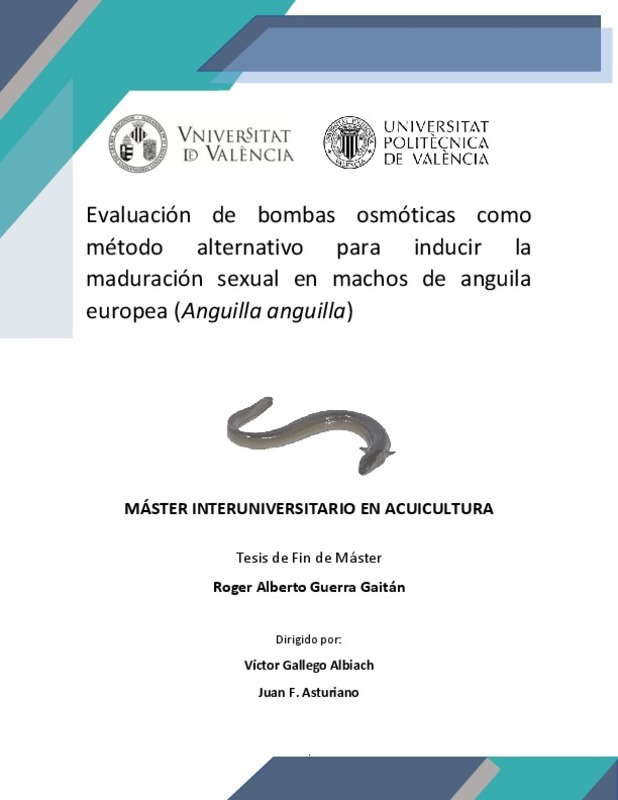|
Resumen:
|
[ES] La anguila europea (Anguilla anguilla) es una especie importante para la acuicultura europea, siendo muy apreciada tanto en el mercado europeo como en el asiático. Sin embargo, su producción actual todavía se base en ...[+]
[ES] La anguila europea (Anguilla anguilla) es una especie importante para la acuicultura europea, siendo muy apreciada tanto en el mercado europeo como en el asiático. Sin embargo, su producción actual todavía se base en el engorde de anguilas capturadas en el medio natural, debido a que aún no es posible reproducir anguilas en cautividad. Además, se ha observado una disminución drástica en el número de anguilas europeas que migran desde Europa y el norte de África a los lugares de puesta en el Océano Atlántico, lo que ha llevado a que la especie se incluya en la lista roja de la UICN como en peligro crítico de extinción. Por tanto, la cría en cautividad se postula como la única sostenible para preservar esta especie i) reduciendo la presión sobre las poblaciones naturales, ii) facilitando el suministro a las granjas acuícola, y iii) permitiendo la repoblación en zonas donde históricamente se encontraba distribuida esta especie.
El objetivo de este estudio fue evaluar la aplicación de métodos alternativos (bombas osmóticas ALZET®) para la inducción de la maduración en machos de anguila europea. Estos sistemas se evaluaron tanto en téminos biológicos como económicos, con la intención de diseñar protocolos capaces de inducir la espermatogénesis en esta especie. Los resultados mostraron que la implantación de bombas osmóticas ALZET 1004 (grupo OP-100) y ALZET 2006 (grupo OP-200), indujo la maduración y producción de esperma en machos de anguila europea. En cuanto al índice gonadosomático (IGS), los grupos implantados con bombas osmóticas alcanzaron valores de 2.23 ¿ 0.81 (OP-100) y 3.06 ¿ 1.43 (OP-200), sin embargo, en general, todos estos valores se encontraron por debajo de los resultados obtenidos mediante tratamientos a base de inyecciones semanales de hCGrec (grupo Control). En cuanto a la producción del esperma, los grupos experimentales (OP-100 y OP-200) alcanzaron volúmenes de hasta un 1 mL/100 g pez, densidades de hasta 5 x 109 (OP-200) y 10 x 109 espermatozoides/ mL, y porcentajes bajos de motilidad de aproximadamente 10% de células móviles. Finalmente, desde un punto de vista económico, el coste de las bombas osmóticas es muy elevado, y por tanto no representó una inversión rentable en términos económicos.
Por lo tanto, este estudio ha demostrado que la utilización de sistemas de liberación controlada (bombas osmóticas ALZET®) induce la espermatogénesis y espermiación en machos de anguila europea, pero sin el potencial necesario para producir una cantidad suficiente de gametos (volumen densidad) con parámetros de calidad espermática (motilidad) aceptables que puedan satisfacer las necesidades de una hatchery de anguilas a nivel comercial.
[-]
[EN] The European eel (Anguilla anguilla) is an important species for European aquaculture, being highly appreciated both in the European and Asian markets. However, its current production still consists in the fattening ...[+]
[EN] The European eel (Anguilla anguilla) is an important species for European aquaculture, being highly appreciated both in the European and Asian markets. However, its current production still consists in the fattening of eels captured in the natural environment, due to the fact that it is not yet possible to reproduce eels in captivity. In addition, a drastic decrease has been observed in the number of wild European eels migrating from Europe and North Africa to the spawning sites in the Atlantic Ocean, leading to the species being included in the IUCN red list as critically endangered. Therefore, breeding in captivity is postulated as a key alternative in order to save this species, which will help to reduce the pressure on natural populations, it will facilitate the supply to the eel farms, and it will allow repopulation in areas where those that historically were located the eel.
The objective of this study was to evaluate the application of alternative methods (ALZET® osmotic pumps) for the induction of maturation in male European eel. These systems were evaluated both in biological and economic terms, with the intention of designing protocols capable of inducing spermatogenesis in this species. The results showed that the implantation of osmotic pumps ALZET 1004 (group OP-100) and ALZET 2006 (group OP-200) induced the maturation and production of sperm in male European eels. Regarding the gonadosomatic index (IGS), the implanted groups with osmotic pumps reached values of 2.23 ¿ 0.81 (OP-100) and 3.06 ¿ 1.43 (OP-200), however, all these values were below the results obtained by treatments based on weekly injections of hCGrec (Control group). Regarding sperm production, the experimental groups (OP-100 and OP-200) reached volumes of up to 1 mL / 100 g fish, densities of up to 5 x 109 (OP-200) and 10 x 109 sperm / mL , and low percentages of motility of approximately 10% of mobile cells. Finally, from an economic point of view, the cost of osmotic pumps was very expensive, so they did not represent a profitable investment in economic terms.
Therefore, this study showed that the use of controlled release systems (ALZET® osmotic pumps) induces spermatogenesis and spermiation in European eel males, but without the potential necessary to produce a sufficient amount of gametes (volume density) with acceptable sperm quality (motility) parameters that can satisfy the needs of a commercial eel hatchery.
[-]
|







